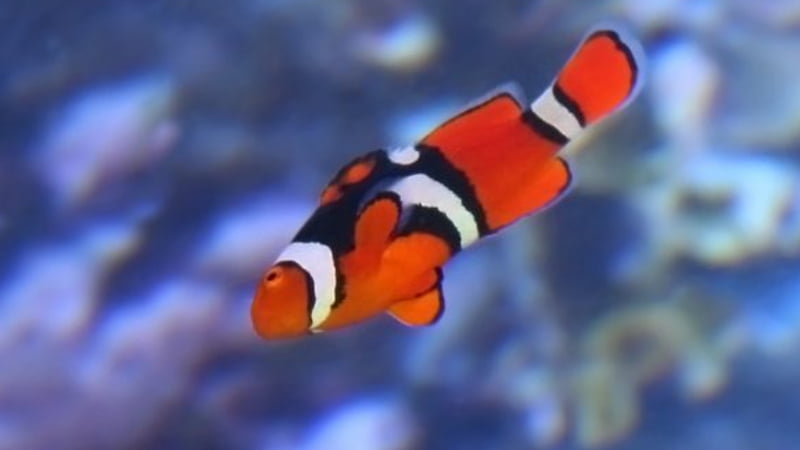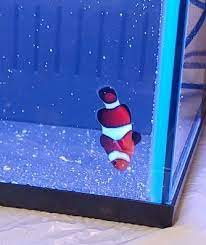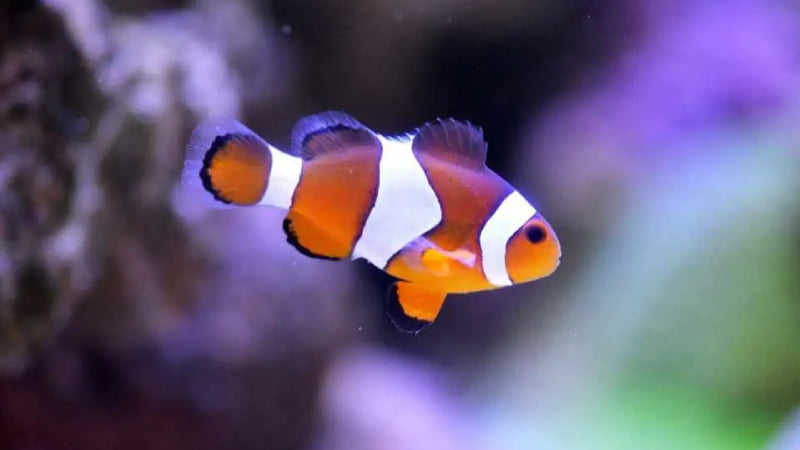Swim bladder disease is a condition that affects clownfish and other marine life. Clownfish swim bladder disease can be fatal if left untreated, as swim bladder problems affect how the fish swims and feeds.
Here are three symptoms of swim bladders diseases in clownfish and treatment options for swim bladder disease in saltwater aquariums.
See also:
- Clownfish Fin Rot: Top 6 Important Things You Need To Know
- Brooklynella Clownfish Disease: Symptoms And Best Treatment
Definite Swim Bladder Disease Clownfish
All clownfish have an organ that floats them in the water. The organ is called a swim bladder and weighs them down until they can release gas to keep them at the right level of buoyancy. A fish with a disease affecting their swim bladder may need help keeping their air bladder inflated or deflated to keep from sinking
A swim bladder is an organ that allows a clownfish to adjust its buoyancy. Clownfish without this capability relies on capillarity for their buoyancy. Clownfish are one of many species that suffer from conditions that interfere with this mechanism, losing the ability to control their buoyancy and sink into the seafloor or rise towards the surface where they cannot breathe.

What Is Swim Bladder Disease?
Swim bladder disease is a term used to describe a sick or injured fish unable to hold itself upright or maintain its position in the water.
Swim bladder disorder is a condition when the swim bladder does not function normally due to disease, physical abnormalities, mechanical/environmental factors, or for reasons that cannot be diagnosed. Affected fish will exhibit problems with buoyancy which includes difficulty controlling their ability to float or sink.
Find Out The Symptoms Of Swim Bladder Disease
A common symptom of swim bladder disease is a fish that has trouble staying upright with its head up or so does not rise to the surface.
Some fish with swim bladder disease bob back and forth in the water, down then up. Other times they may just appear to be laboring or swimming really hard just to stay in place.

Why Is A Clownfish Being Swim Bladder Disorder?
This disorder can be caused by compression of the swim bladder, which may be exacerbated when a fish gulps air and eats rapidly. Eating freeze-dried or dry flake food that expands when it becomes wet can also lead to an enlarged stomach or intestinal tract.
There are some reasons that lead to swim bladder disease:
- When the water is too cold, it can slow the process of digesting food and puts pressure on your swim bladder.
- Other organs of the body can also become enlarged and affect a fish’s swim bladder. Cysts in the kidneys, fatty deposits in the liver, or egg binding in female fish all result in an enlargement that interferes with the normal function of the swim bladder.
- Parasites or bacterial infections may also lead to inflammation of the fish’s swim bladder. An extremely hard blow from striking an object in the tank, a fight, or a fall can set off such a circumstance.
- Some fish are born with defects affecting the swim bladder, but in these cases, symptoms usually appear early on.
Treatment For Swim Bladder Disease Clownfish
If a swim bladder disorder is caused by an enlarged stomach or intestine, feed the fish for three days without food. At the same time, keep your water temperature at 78-80 degrees and don’t change anything else during treatment.
Feed the fish a cooked and skinned pea on day four. Frozen peas are best because they can be microwaved or boiled for a few seconds, which will produce the right consistency (neither too soft nor too firm).
Feed a pea, or similar-sized food item to the fish and continue this for a few days. Then, replace with a species-appropriate food source that will not float such as cooked seafood pieces.
If your fish is showing signs of swim bladder disease, it may be due to an infection. Such infections can often be treated with a broad-spectrum antibiotic from your vet
Basing on the causes, I recommend some other treatments as following:
- Keeping a clean water tank and stay water temperature constantly between 78 and 80 degrees Fahrenheit
- Adding a small amount of aquarium salt to their tanks and observing positive improvements in the condition.
- Getting in the habit of reducing the water level to help it move around easier within the tank.
- Blocking the flow of water in tanks with a strong current
- If the fish is showing signs of floating with the unprotected surface area out of the water, a stress coat can be applied to help avoid problems such as sores.
- If a fish has trouble swimming normally, hand feeding may be necessary.
Preventing Swim Bladder Disease In Clownfish
Clownfish are saltwater fish that are easy to care for. They have long lifespans and don’t usually cause any problems for their owners. Therefore, try your best to apply these below advice to protect your clownfish from getting swim bladder disease:
- Keep the pH and temperature of your aquarium water stable for optimal health
- Provide your fish with a healthy mix of plants and protein in their diet
- When feeding your fish, be careful not to overfeed.
- Quarantine any new fish before transferring them to your main tank
Clownfish are tropical fish and, as such, need temperatures to be kept at 72-78 deg F, salinity at 1.020 to 1.025sg. The pH in saltwater aquariums should be kept between 8.1 and 8.4 with alkalinity remaining somewhere between 8 dkh and 12 dkh
To keep your fish healthy, it’s a good idea to test water parameters weekly. This way, adjustments can be made before any problems emerge or the fish get stressed out.
Clownfish can eat both plants and live food. Offer some variety with their diets such as marine flakes, pellets, frozen fish food, and seaweed sheets. Clownfish’s favorite is shrimp; mysids, krill, or brine will do just fine.
Always soak your fish flake in tank water before feeding them. This will prevent the food from bloating and becoming indigestible to your fish. For better nutritional content, you can use liquid marine vitamins like silicon or garlic oil once or twice a week to soak the food instead of only relying on freshwater.
Do not feed frozen food to clownfish. Thaw a cube and drain the water before putting it in the tank.
Clownfish will also do well to eat vegetables such as chard, spinach, spirulina, and nori.
Clownfish are not choosy eaters, but their health depends on a varied diet. Feed them slowly and be prepared to add some food to the tank if your clownfish refuse it all at once. Feeding should be done in two small sessions per day.
Always make sure all your fish are treated well, and inspect them regularly for any signs of injury.
Providing hiding and play areas for your saltwater tank can be difficult without the addition of an anemone. Corals, clams, and live rock are all fitting options in a tank with no cavity animals.
Video: Clownfish Problem, Swinbladder
FAQs
What is a swim bladder?
As with most of their anatomy, the swim bladder of a fish is responsible for balancing both their swim and buoyancy activities.
A swim bladder, which is known as an air bladder, is filled with gas and placed near the center of a fish. It’s associated with the ball on the spinal column.
Fish have swim bladders, but not all of them do.
What are the sights when a clownfish having a swim bladder disorder disease?
Fish suffering from swim bladder disorder exhibit a variety of symptoms, including sinking to the bottom or floating at the top of the tank, floating upside down or on their sides, or struggling to maintain a normal buoyancy.
Other physical signs of swim bladder disease may also be present in the affected fish. Affected fish may eat normally, or have no appetite at all. If severe buoyancy problems exist, the fish may not be able to feed properly and/or reach up for oxygen, depending on where it is in its cycle of illness.
What leads to swimming bladder disease?
Despite not knowing the root cause of swim bladder disease, many theories have been proposed.
Theories include: A difference in salinity between home and public aquariums causes fish to drink more than they would at home, changes in diet-related to behavior changes or signs of illness, etc
Conclusion
Multiple issues are responsible for a swim bladder disorder, not just one. The disease is most commonly seen in goldfish and bettas but can affect virtually any animal.
If your clownfish has any of those symptoms above, hope my article will help with your problems. Many thanks for reading!

Annette M. Chaney is an experienced marine biologist with over 20 years of experience as an aquarist and fishkeeper. She started her first aquarium at a young age, filling it with frogs and goldfish obtained from the ten-cent pet store.
Annette grew up caring for and breeding African Cichlids, which led to a hobby in high school that doubled as a profitable means. Attending Reed College gave her time to solidify herself as an accomplished aquarium caretaker with an eye for sales. After that, from 2009 – 2013, she studied at Roger Williams University – one of the most prestigious universities for Aquaculture and Aquarium in USA. She is the founder of AquariumCircle since 2010.
